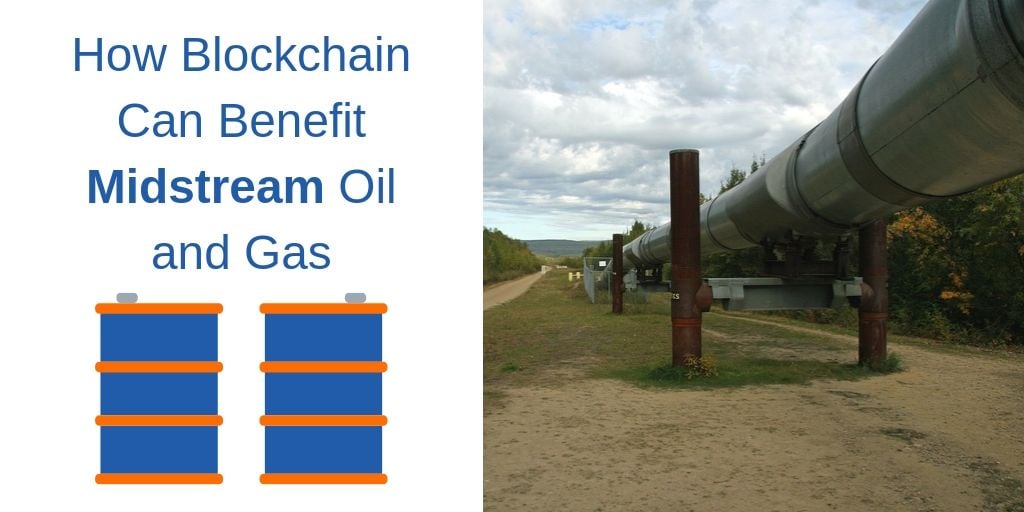
In this series, we’re breaking down how blockchain can impact the complex segments of the oil and gas industry: upstream, midstream, and downstream.
As we mentioned in the first part of this series, there are three segments of the oil and gas industry: upstream, midstream, and downstream. Linking the upstream segment (exploration and production) and downstream segment (refinement), midstream oil and gas includes the transportation and storage of natural gas, crude oil, and refined products.
Due to the potential of environmental harm from improper storage or transportation, midstream oil and gas is one of the most regulated industries. And because oil and gas products have to pass through national, state, local, and municipal borders, they must successfully attain a wide variety of approvals. While midstream oil and gas businesses struggle to juggle regulations with their many partners, blockchain has the capability to mitigate these problems.
Let’s dive into 4 ways that blockchain can benefit the midstream oil and gas industry, from enabling multi-channel transportation tracking to leveraging shared resources.
Enabling Multi-Channel Transportation Tracking
Transportation is a key part of midstream oil and gas. Businesses transport crude oil and natural gas by rail, cargo ship, and sprawling interstate pipeline networks.
Tracking the location and flow of crude oil and natural gas is a top priority to midstream businesses. As their assets travel from wells to refineries via cargo routes, railways, and pipeline infrastructure, midstream businesses need up-to-date records of their progress. But with older technology, businesses often can’t track items with granular detail in real-time — and if they can, they can rarely do so from a single, centralized interface.
With a blockchain database, permissioned stakeholders can have full visibility into the location of their assets throughout the supply chain. Access to this real-time data in a trackable database empowers leadership to analyze the supply chain as a whole, identify areas of concern, and make well-informed business decisions.
Streamlining Infrastructure Maintenance
Most crude oil and natural gas travels through complex industrial infrastructure, particularly pipeline networks. For assets to move on schedule, businesses have to ensure that infrastructure is properly maintained.
However, railroads and pipeline networks are managed and overseen by multiple parties, both public and private. Network examinations are conducted by one party, affirmed by additional public and private parties, and then recorded. This process is often undertaken manually, communicated about through email, and recorded in each individual business’s system. Considering the number of stakeholders involved in infrastructure maintenance and regulation, recording this data in silos can be detrimental. Tracking down records can take days, which holds up production and decreases profitability.
With blockchain, infrastructure maintenance is a streamlined process. All maintenance stakeholders can upload certification and maintenance records to a single, shared ledger and enable access to relevant parties. This ensures that critical, accurate maintenance information is available in real-time.
Improving Quality Bank Reconciliation
As any midstream oil and gas business knows, products in pipelines have an average pipeline quality. However, each business’s batch enters the network with a specific quality level that can be higher or lower than the average. Businesses that contribute a higher quality product deserve more compensation than those providing a lower quality product. Enter quality banks, which confirm quality and compensate or charge companies with higher or lower quality products.
Many midstream oil and gas producers want more insight into decisions made by quality banks, which currently charge or compensate businesses with some clarity, but often not as much or as quickly as midstream businesses would like. Without transparency into the pipeline’s quality, midstream companies must trust quality banks without immediate data to back up their claims.
With a data system that relies on blockchain, quality banks can maintain a real-time record of overall pipeline quality, incoming product quality, and any compensation or charges. Then, that data can be shared with permissioned stakeholders so they can gain transparency into the reconciliation process. The addition of smart contracts empowers businesses to receive compensation or make payments in real-time, right as their product enters the pipeline. This saves on back-office reconciliation costs.
Better Leveraging Shared Resources
At the end of the day, midstream oil is all about shared resources. Businesses share pipelines, railroads, maintenance duties, and even the valuable assets themselves.
Because midstream oil and gas businesses have to work together in so many ways, blockchain is a must-have technology for transparent, fair collaboration. With the improved visibility and coordination blockchain brings, individual businesses can increase their efficiency — and boost profits in turn.
Without a connected solution that encourages accuracy and collaboration, it is difficult for intertwined midstream oil and gas businesses to work together. But with the help of blockchain technology, midstream businesses can enable multi-channel transportation tracking, streamline infrastructure management, improve quality bank reconciliation, and better leverage shared resources.
Vertrax has partnered with IBM to bring a blockchain solution to the oil and gas industry. Let us know if you're interested in learning more!
In the next installment of this series, we’ll explore the role blockchain can play in the downstream segment of the oil and gas industry.

